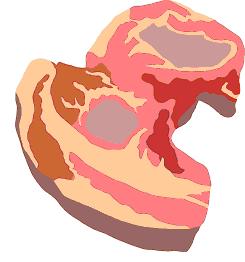Using a Steak Analogy to Prevent Low Back & Neck Pain
Reference:1. D’hooge R, et al Increased intramuscular fatty infiltration without differences in lumbar muscle cross-sectional area during remission of unilateral recurrent low back pain. Man Ther. 2012 Dec;17(6):584-8.
2. Elliott JM, et al Magnetic resonance imaging findings of fatty infiltrate in the cervical flexors in chronic whiplash. Spine (Phila Pa 1976). 2010 Apr 20;35(9):948-54.
How can “steak” help your patients with back and neck pain and motivate them to exercise? Please read on.
Although debatable, there have been dozens of articles supporting the hypothesis that those with low back pain (LBP) have significant loss of cross sectional area (CSA) of specific muscles (e.g. multifidus, erector spinae and psoas). They have shown that even after several months when LBP has resolved, the muscle atrophy still persists.
It is hypothesized that this loss of CSA may increase the risk of recurring LBP, which makes sense. However many patients with recurring LBP do not have a loss of CSA of their muscles… neither visible by the naked eye nor on imaging. If a muscle has not atrophied, does that mean it is normal?
A team of Physiotherapists in Belgium (D’hooge et al 2012) have attempted to answer this question by using MRI to calculate not just the size but also the muscle-fat-index of subjects with a history of LBP but in remission.
This recent study showed that although compared to the control subjects CSA of the lumbar muscles was not necessarily lost, the LBP subjects had significantly higher muscle-fat-index or “fatty infiltrations” in their lumbar muscles.
Similarly, studies on patients with chronic whiplash have shown actually an increase in the cervical muscle CSA, however do not get fooled by the increase in muscle size as it was discovered that the fatty infiltrations (a.k.a. intramuscular fat) accounted for the enlarged size (Elliot et al 2010).
Clinical application: Use the steak analogy. Imagine 2 pieces of raw steaks one is lean dark red meat and the other is surrounded and filled with white fat. Never mind which one you would prefer to eat, but which muscle would you want in your back when twisting and lifting?
An inactive lifestyle and prolonged sitting may contribute to fatty infiltrations growing in our healthy red muscles. Tell your patients that the single best way known to prevent or possibly reverse fatty infiltrations and perhaps future recurrences of low back and neck pain is to stay active and perform some form of resistance training exercises on a daily basis!
Have a 5kg medicine ball on the floor beside your desk. Lift it up from the floor and take it over your head ten times every 2 hours. This is one of the many ways of preventing invasion of our muscles by the evil fatty infiltrations.
Posted on: February 21, 2013
Categories: Cervical Spine , Lumbar Spine


